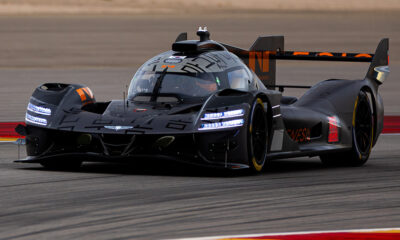Several teams were given mechanical black flags at the Sahlen’s Six Hours of The Glen after a rules change related to tire pressures that had a “significant impact” on the race according to one team manager.
A total of ten cars in the GTP, GTD Pro and GTD classes were ordered into the pits to change tires because their pressures were either too low or a sensor had malfunctioned.
The high number of mechanical black flags was unusual for the IMSA WeatherTech SportsCar Championship but could be explained by a change to the regulations issued before Watkins Glen.
The updated rulebook stated that failure to adhere to the lower tire pressure limit “may result in” the minimum requirement of “stop and repair” using the black and orange flag.
Previously, the first port of call for low or faulty tire pressure readings was a warning, but the affected teams at Watkins Glen were ordered to pit within four laps.
It is understood that most of the mechanical black flags were given for tire pressures that were below the IMSA-assigned minimum.
However, at least two are known to have been attributed to sensor failures, with the Wayne Taylor Racing with Andretti Autosport Acura ARX-06 and the Forte Racing by US RaceTronics Lamborghini Huracan GT3 EVO2 being impacted in that way.
Tire pressure sensors in the WeatherTech Championship are provided by the car manufacturers, rather than IMSA or a single external supplier, and are not currently equipped on LMP2 and LMP3 cars.
“We respect the requirements from IMSA and Michelin to regulate tire pressures,” said Corvette Racing team manager Marc Maurini, whose No. 3 Chevrolet Corvette C8.R GTD received a mechanical black flag in the third hour.
“However, at Watkins Glen, the enforcement of these regulations significantly impacted the race in ways that may not have been obvious at first glance.
“Open communication between IMSA and the teams to improve implementation of the sporting regulations is the preferred path forward.
“A level playing field with minimal impact of the sporting regulations on race results is in the best interests of the fans, teams and IMSA.”
Iron Lynx team principal Andrea Piccini and Risi Competizione engineer Rick Mayer both highlighted the impact that variable track temperatures played during the six-hour race.
The No. 83 Iron Dames Lamborghini, which was a GTD front-runner, and the Risi Ferrari 296 GT3 were given mechanical black flags at the same time approaching halfway.
“Even on the other [Iron Lynx] car we were really close,” Piccini said. “It was 0.01 [PSI] higher [than the limit]. It was 86 on that car and 84 or 85 on the [Iron Dames].
“I think everyone was on the edge during that stint because the track temperature dropped rapidly, because it got cloudy. I think that’s why they penalized so many cars.
“They’ve never been so aggressive with this rule as they have been here.”
Mayer added: “Basically, we set the pressures for the sun, then the shade came over and the track [temperature] dropped.
“I’m wondering what IMSA’s going to do. Say you go out on wets and it’s a drying track, and you’ve got your pressures set, and all of a sudden a deluge of rain comes.
“Your pressures drop well below the limit. Are you going to call every car on the track in for [illegal] pressures?”
The affected cars lost several positions when they were given the mechanical black flag, although most were able to recover the lost ground under full course caution periods.
However, a smaller number of cars were ordered to pit during the second half of the race, including both Aston Martin Vantage GT3s from The Heart of Racing that were second in GTD Pro and third in GTD at the time.
“For us, it happened late in the race, so it was really hard,” said Heart of Racing team principal Ian James. “There were so many cars that had it. Rules are rules, and we have to adhere to them.
“But it would be better to understand where the tires are going pressure-wise because they were all equal on our data.
“They must have been too low, otherwise we wouldn’t have got dinged for it. They were exactly the same pressures that went on the stint before, and we were 1 PSI over in that stint, which is not enough margin.
“We got dinged on one tire. We just need to understand it a little bit.”
Sportscar365 has reached out to IMSA for comment, although it has yet to reply at the time of the article’s publishing.



























